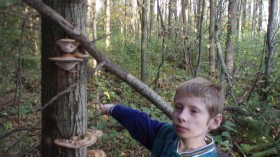Trails: All trails were rolled on Saturday after a 2″ snowfall the night before. Good base, but not enough to set a track. Some grassy spots in wooded areas.
 Over the years, Crossroads has hosted a number of superb programs on physics, but our guest speakers never have been able to explain the mystery of how packages, lovingly wrapped and neatly arranged under a Christmas tree, so quickly become clutter. I mean, how can packaging have a greater volume than the original package after the contents are removed? If that doesn’t defy physics, I don’t know what does.
Over the years, Crossroads has hosted a number of superb programs on physics, but our guest speakers never have been able to explain the mystery of how packages, lovingly wrapped and neatly arranged under a Christmas tree, so quickly become clutter. I mean, how can packaging have a greater volume than the original package after the contents are removed? If that doesn’t defy physics, I don’t know what does.
My first reaction, of course, is dismay. I’m not overly fond of housework. So much to throw away! Then, and more importantly, I have to wonder if all of this packaging is really necessary. By now, everyone must be aware that we have an extremely serious solid waste problem. Yet we wrap and double wrap our products as if there were no tomorrow. And to make it worse, many packaging materials are made from non-recyclable foams and plastics. And even if the materials can be recycled, are there facilities and markets in place to cope with all of the solid waste we throw away?
If you want to see a recycling program that works, look at nature. Think of the volume of debris created by plants and animals. Then think of the solid waste problems in nature. You can’t? Solid waste is a uniquely human problem.
In nature, microorganisms and fungi are constantly at work, breaking down organic mater into its component parts. Winter is a good time to see the mushrooms growing on trees (both living and dead.) Mushrooms are essentially the fruits of fungi. The recycling agents are threadlike strands which grow through the wood. Called mycellium, these thread are invisible to the to the human eye unless many threads are matted together.
As mycelium penetrate the wood, they release enzymes from their tips. This breaks down the wood into food, which is used by the fungus, but ultimately returns to the soil as nutrients. Thus generation after generation are able to use and reuse a limited supply of natural fertilizer.
We humans have limited supplies of our resources. Wouldn’t it be sensible……isn’t it imperative… that we use and reuse our resources from generation to generation? Sure we can throw our clutter away, just like Christmas wrappings. But where is away?
For the year 2013, Crossroads has selected “Biodiversity” as its educational theme. We will continue to offer programs covering all aspects of science, history and the environment, but whenever possible, we will focus on living things from the tiniest microbe to the largest tree. We will study plants, animals, fungi and how they interact with each other and with their environment. And we also plan to increase the diversity of plants and animals on our property.
We also want to help people get in touch with nature. When there is adequate snow, Crossroads grooms trails for traditional cross-county and skate skiing and also rolls are trail for hikers/pet walkers. These trails are open every day (except when deteriorating conditions makes skiing impossible) We request that hikers stay off the designated ski trails. Each Sunday afternoon when conditions are good, we hold a Community Ski, inviting members of the community to use our skis and snowshoes free of charge. Loaner skis are available between 1:30-3:30 on Sundays and we ask that equipment be returned by dark.

